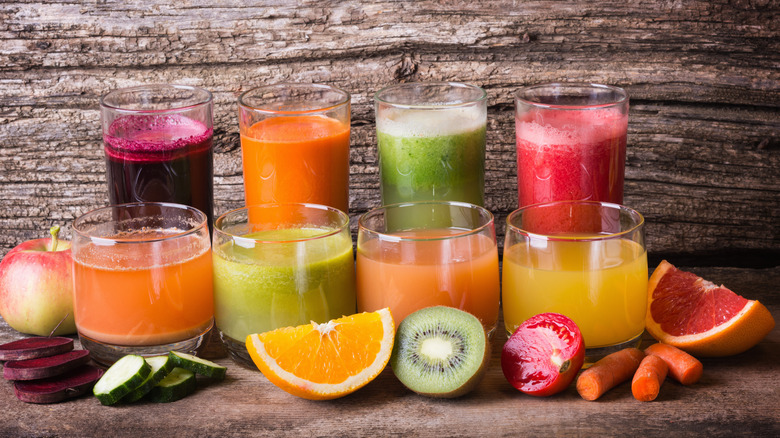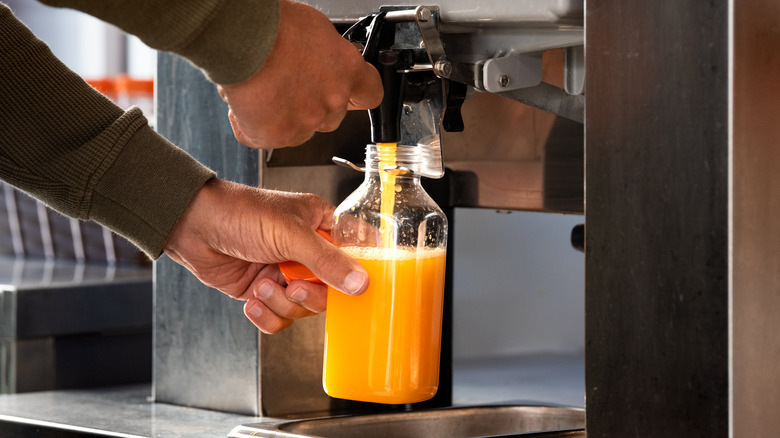What Ever Happened To Juicero?
While store-bought juices are notorious for added sugars and other unhealthy ingredients, juicing is a much better option that extracts the very essence from fruits and vegetables. While it's challenging to pinpoint just when Americans became obsessed with juicing, Citizens of Humanity cites David Otto's Beverly Hills Juice Club as a defining moment. Otto was apparently inspired to become a vegetarian by a psychedelic drug-induced experience he had at a steakhouse, wherein his meal morphed into a bull and helped Otto see the error of his meat-eating ways. If only all business origin stories were that interesting.
When it comes to Juicero, a high-end juicer that promised a seamless, mess-free juicing experience, it seems that CEO and founder Doug Evans was looking for a new opportunity after selling his Organic Avenue juice bars, according to Forbes. However, Tech Crunch reports that Evans parted ways with Juicero only six months after the product had hit store shelves. The company continued its decline throughout 2017, until finally shutting down in September of that year per CNBC. With such promise at the outset, many people naturally wonder just where Juicero went wrong.
A jaunt through the Juicero process
Insider provides some much-needed insight into Juicero and its epic rise and fall. Upon release, the juicer was priced at a whopping $700, although the price was swiftly reduced to $400. In addition to the juicer itself, customers had to purchase individual packets containing raw ingredients for $5 to $7 each. The packets came with a QR code, which provided information on the ingredients as well as the expiration date. The QR code also meant that only Juicero packets could be used with the devices, which prevented other companies from making their own and potentially luring away customers.
So, what's it like to use an exorbitantly expensive juicer? According to a reporter for Insider, the process entailed loading the packet into the machine, pressing a button, and waiting for that sweet, sweet juice. The juicing process would take about two minutes or so, at which point a glass of unbridled wellness was yours to enjoy. As stated by the reporter, Juicero juice was "really good," but not necessarily the life-altering experience touted by Evans. Also, it seemed that the ultra-expensive juicer was actually not as vital as one would believe.
Putting the squeeze on innovation
Juicero's insane price point gave lots of people pause, even after it had been reduced. However, a revelation provided by Bloomberg proved to be the gadget's undoing in terms of consumer confidence. Along with the juicer's impressive technology, many investors were charmed by the subscription model of the juice packets, which meant customers would continue to patronize the business long after their initial purchase. In fact, investors were so charmed that various entities contributed $120 million to the project to get it off the ground. Despite initial enthusiasm, investors were less impressed by the discovery that these juice packets could be effectively squeezed by hand, meaning that the device itself was little more than a $400 paperweight.
Upon learning of the development, a reporter from Bloomberg decided to wring packets by hand to see if it was effective. Surprisingly it was, although the juicer was able to squeeze an additional .5 ounces of juice out of the packet. However, handwringing was faster and an expiration date on the packet made the QR code somewhat obsolete regarding spoilage information. And when a fellow product designer decided to take apart the juicer just to see how it worked, per Ars Technica, he determined the device had "unnecessary complexity," and that alterations to the design would have drastically reduced its price point.


